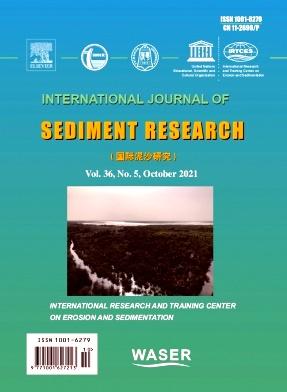Sediment nitrogen form occurrence associated with its ecological risk in the Yangtze River Delta plain-river network
IF 3.7
2区 环境科学与生态学
Q2 ENVIRONMENTAL SCIENCES
引用次数: 0
Abstract
The Yangtze River Delta, renowned for its intricate waterway system and fertile soil, is a crucial ecological zone in China. However, anthropogenic activities have led to significant changes in sediment nitrogen (N) forms and associated ecological risks in this region. This study aims to comprehensively investigate the occurrence of various N forms in the sediment of the Yangtze River Delta plain-river network through field sampling and laboratory analysis and to assess their ecological implications. The results revealed that the concentration of total N in river water (TNw) ranged from 1.24 to 5.96 mg/L, decreasing from northwest to southeast. The nitrate in river water () was the major species of TNw, accounting for 67.97% of the total. The average values of TN, total carbon (TC), and total sulfur (TS) in the sediment were 1.97, 18.36, and 1.35 mg/g, respectively. The predominant N fractions in the sediment were residual nitrogen (RN) (72.42%) and hydrolyzable nitrogen (HN) (22.44%). The ammonia in river water () was significantly affected by the sediment N (p < 0.05). Residential density (RD) and industrial density (ID) were significantly positively correlated with the concentration of TNw (p < 0.01), and ID was significantly positively correlated with increased RN (p < 0.05), which suggests that industrial wastewater may be a source of RN. The risk assessment revealed that 36% of the sediment samples were above the moderate TN pollution level. Furthermore, 94% of the sediment was contaminated with organic matter, with 66.7% specifically affected by organic N contamination. High riverine RN and contents indicate serious ecological pollution risks in the complex river network area in the Yangtze River Delta. This study provides valuable insight into N cycling and associated ecological risks in the Yangtze River Delta plain-river network, which is crucial for developing effective management strategies to safeguard the ecological health of this vital region.
长江三角洲平原河网沉积物氮形态赋存及其生态风险
长江三角洲以其复杂的水路系统和肥沃的土壤而闻名,是中国重要的生态区。然而,人类活动导致该地区沉积物氮形态发生了显著变化,并带来了相应的生态风险。本研究旨在通过野外采样和室内分析,全面了解长三角平原河网沉积物中各种形态氮的赋存情况,并评价其生态意义。结果表明:河流水体总氮(TNw)浓度在1.24 ~ 5.96 mg/L之间,由西北向东南递减;河流水体中硝酸盐(NO3−-Nw)是TNw的主要种类,占总数的67.97%。沉积物中TN、TC和TS的平均值分别为1.97、18.36和1.35 mg/g。沉积物中主要的氮组分为残余氮(RN)(72.42%)和水解氮(HN)(22.44%)。水体氨氮(NH4+ -Nw)受沉积物N (p <;0.05)。居住密度(RD)和工业密度(ID)与TNw (p <)浓度呈显著正相关;0.01), ID与RN升高呈显著正相关(p <;0.05),说明工业废水可能是RN的来源之一。风险评价结果显示,36%的沉积物样本TN污染中度以上。94%的沉积物受到有机质污染,其中66.7%的沉积物受到有机氮污染。长三角复杂河网区高的河流RN和NO3−-Nw含量预示着严重的生态污染风险。本研究为深入了解长三角平原河网氮循环及其相关生态风险提供了有价值的信息,对于制定有效的管理策略以保障这一重要区域的生态健康具有重要意义。
本文章由计算机程序翻译,如有差异,请以英文原文为准。
求助全文
约1分钟内获得全文
求助全文
来源期刊
CiteScore
6.90
自引率
5.60%
发文量
88
审稿时长
74 days
期刊介绍:
International Journal of Sediment Research, the Official Journal of The International Research and Training Center on Erosion and Sedimentation and The World Association for Sedimentation and Erosion Research, publishes scientific and technical papers on all aspects of erosion and sedimentation interpreted in its widest sense.
The subject matter is to include not only the mechanics of sediment transport and fluvial processes, but also what is related to geography, geomorphology, soil erosion, watershed management, sedimentology, environmental and ecological impacts of sedimentation, social and economical effects of sedimentation and its assessment, etc. Special attention is paid to engineering problems related to sedimentation and erosion.

 求助内容:
求助内容: 应助结果提醒方式:
应助结果提醒方式:


